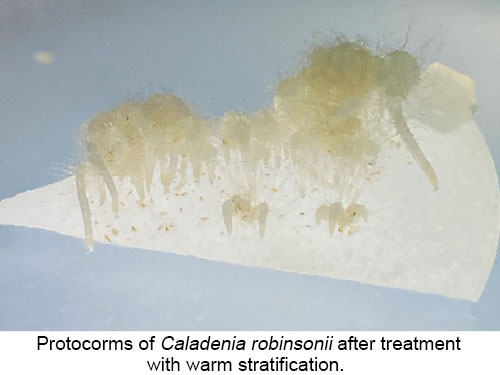<< BACK TO PROJECT LIST
Project: 344/2022
Title: Warn stratification for improved in-vitro germination in Australian terrestrial orchids
Applicant: Brendan Janissen
Institution: Aceae Environmental
Address: 35 Sheila Street, Preston Vic 30782
Seed germination in orchids requires three essential factors: environmental conditions (temperature, moisture, light/dark) conducive to germination, primed ‘ready-to-germinate’ (not dormant) seed and (unlike most other plants) a symbiotically effective fungus. Conservation efforts for many threatened orchids have been limited by poor germination in vitro; this is probably because one or more of the critical factors for germination previously mentioned is not being met. ‘Ready-to-germinate’ seed is the least studied of these critical factors and has potential to improve in vitro germination success.
In some northern hemisphere orchids, ‘ready-to-germinate’ seed has been achieved using cold stratification to simulate the environmental conditions in situ after seed dispersal. For example, cold stratification increased the proportion of seeds germinating in Platanthera chapmanii from 25% to 35%. Similarly, germination in Calopogon tuberosus increased from <45% to >60% after cold stratification at 10°C for 8 weeks. However, cold stratification at the temperatures used in northern hemisphere summer-flowering orchids before spring germination is unlikely to be relevant for spring-flowering, winter-active orchids with seed that germinate in autumn at the end of a hot dry summer.
For spring-flowering, winter-active orchids, seeds would be exposed to the warm temperatures of summer before germinating in autumn when temperatures drop. This suggests that warm stratification would be required to simulate in situ conditions and trigger germination. A recent study on Caladenia robinsonii demonstrated the positive effects of warm stratification on germination. Warm stratifying inoculated seed for 1 week at 30/27°C (12/12 h) in darkness increased total germination by almost 2-fold. It also increased the proportion of seeds reaching later stage development (green leaf formation). Supplementary studies on Diuris fragrantissima have shown similar positive results but more research is required to determine if this method can be used broadly for orchid conservation.
The aim of this project is to investigate the broad applicability of warm stratification and its potential to improve conservation efforts by testing it on several species from multiple genera. Within each genus, species with different phenology will be tested to confirm if the positive effects are a result of simulating in situ condition after seed dispersal. I.e., mimicking environmental cues that alleviate dormancy and produce ‘ready-to-germinate’ seed.

